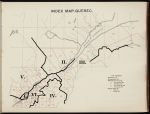Well, starting off logically, I think Toronto by itself can be a 3 MIP constituency, and definitely can if you also include the three ridings of York county (I'd probably call that one something along the lines of Toronto - York County to avoid confusion with Yorkshire).
Toronto can indeed form a three-seat constituency all by itself (with a population of
208,040, it would return 2.81 MIPs, rounded up to three.) Creating a York County seat gives us 3.69 MIPs, rounded up to four. I agree that a Toronto-based constituency which encompasses all of York County would be called Toronto--York. My idea for Ontario constituencies is to have at least one based on the five major cities of Ontario at the time: Toronto, Hamilton, London, Kingston, and Ottawa. A sixth seat would encompass what was at the time called "New Ontario" - the North, so named because much of it was only added to Ontario in the late nineteenth century. IOTL, Ontario's borders were finalized in 1912 with the final annexation from the Northwest Territories of the Hudson Bay basin (north of the Albany River, originally called the Patricia District, presumably after then-Governor-General Prince Arthur, Duke of Connaught's popular daughter Princess Patricia, she also of the Light Canadian Infantry IOTL). The boundaries of the "North" are elementary to define because it would encompass all unincorporated districts (i.e. non-counties) of Ontario. On the map (which I will reproduce here on this new page) these are as follows:
Algoma East, Algoma West, Nipissing, Parry Sound, Muskoka, and (the off-map) Thunder Bay and Rainy River. The problem is that these constitute a population of only 117,321, and would return only 1.98 MIPs. In initial maps I added Renfrew County (North and South) to arrive at the magic number (2.68) but this is unfair to the residents of that incorporated county. So I have two options. Either have the Ontarian delegation try to brute force a two-seat proposal for Northern Ontario or put my
very leaden finger on the scale to bring us to three at the expense of one MIP from Southern Ontario. I might go with the former. If I do, that means we split the remaining 28 MIPs five ways. Most evenly distributed, this gives us five Southern constituencies sized 6-6-6-5-5. Toronto-York is only a four-seat constituency, and Torontonian interests won't want their votes diluted by farmers in adjacent Ontario or Peel or Simcoe Counties. (Yes, STV ideally is supposed to prevent that, but these are "FPTP thinkers" who might not
get it right away). If we want more equally-sized districts, we'll want smaller ones. 28 very naturally divides into seven districts of four, for eight total. I came up with eight districts, but they are not all apportioned equal:
 I. Ottawa--St. Lawrence
I. Ottawa--St. Lawrence. Centred on the city of Ottawa, this constituency contains every county which borders either the St. Lawrence River or the Ottawa River (the Ottawa is a tributary of the St. Lawrence and they meet in Quebec territory). The exception is Lanark County, which is very much within the Ottawa orbit. Population 361,611 -
5 MIPs.
II. Kingston--Ontario. Every county east of York County and Lake Simcoe which is not part of Ottawa--St. Lawrence. Most of these border Lake Ontario, hence the name. Kingston, as you can see, is on the extreme eastern end of the constituency. Population 322,069 -
4 MIPs.
III. Simcoe--Huron. Every county which borders either Lake Simcoe or Lake Huron, which does
not border either Lake St. Clair or Lake Ontario. Dufferin County, like Lanark County, is part of this constituency as it is obviously within its orbit. The largest settlement within this constituency is Owen Sound, population 8,776 in 1901, so this is very much a rural constituency. Population 293,781 -
4 MIPs.
IV. Hamilton--Niagara. Every county which borders Wentworth County (of which Hamilton is the seat)
or Lake Ontario west and south of York County,
or the Niagara River. Very much an orbital Hamilton seat, it also contains several other substantial settlements, including Brantford (the sixth-largest city in Ontario, with 16,619 people), Berlin, St. Catharines, and Galt. Population 350,225 -
5 MIPs.
V. London--Erie. An orbital London seat - every county bordering Middlesex County
except those also bordering Lake St. Clair, and also Norfolk County under the same Dufferin-Lanark "regional orbit" exception. Other settlements of substantial size in the constituency are Stratford, St. Thomas, and Woodstock. Population 263,710 -
3 MIPs.
VI. St. Clair. A relic of the Upper Canadian "Western District" which endured for several decades. An agricultural "heartland" riding whose largest settlement is the border town of Windsor, population 12,153. IOTL, of course, Windsor would become the bulwark of the Canadian automotive industry in the early 20th century, though in 1901 the Ford Model T is still seven years away. Population 172,580 -
3 MIPs.
I could have combined London--Erie and St. Clair into a single six-member riding, but that struck me as too large (and a bit sprawling). I actually put my finger on the scale a bit - London--Erie would return 3.57 (4) MIPs and St. Clair would return 2.33 (2) MIPs but I rounded in the other direction.
And the two un-numbered constituencies:
Nipissing--Superior. Named for the two lakes on either side of the constituency. By far the most geographically extensive constituency in Ontario. Consists of all incorporated districts of Ontario,
aka "New Ontario". Population 146,308 -
2 MIPs.
Toronto--York. The
smallest constituency in Ontario, consisting entirely of York County. Toronto comprises over two-thirds of its population. Population 272,663 -
4 MIPs.
That provides us with a distribution of 5-5-4-4-4-3-3-2, with 4 as the median and mode size of each constituency and 3.75 as the mean.
For additional reference as to all 85 federal ridings and their "value" within an Imperial constituency (by hundredths of MIPs) I've concocted another table for reference:





